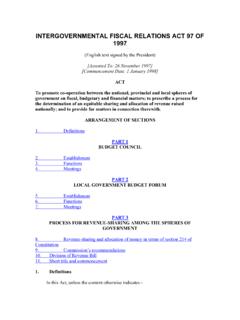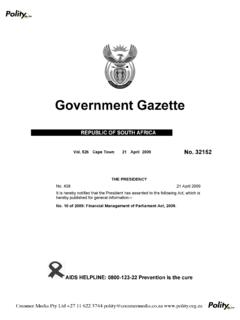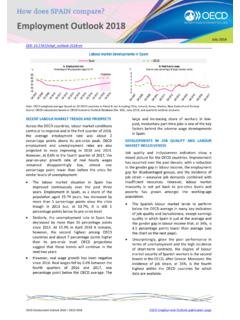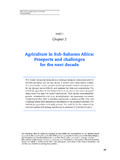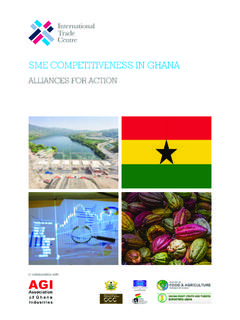Transcription of Submission for the 2019/20 Division of Revenue - ffc.co.za
1 Submission for the 2019/20 . Division of Revenue For an Equitable Sharing of National Revenue 31 May 2018. Financial and Fiscal Commission Montrose Place (2nd Floor), Bekker Street Waterfall Park, Vorna Valley, Midrand. Private Bag X69, Halfway House 1685. Tel: +27 11 207 2300. Fax: +27 86 589 1038. Financial and Fiscal Commission: Submission for the Division of Revenue 2019/20 . 2. Financial and Fiscal Commission: Submission for the Division of Revenue 2019/20 . Contents Contents .. 3. List of figures .. 6. List of 7. Acronyms .. 8. Foreword .. 10. Executive Summary .. 13. 16. Chapter 1: Re-engineering the Intergovernmental Fiscal Relations 25.
2 Introduction .. 25. Economic and fiscal outlook .. 28. The economic 28. The fiscal 33. Socio-economic impact and moving towards 2030 .. 40. Business as usual scenario .. 41. Sustainable Development Goals scenario .. 42. Summary .. 46. Chapter 2: Recentralisation Implications for Service Delivery and Intergovernmental Fiscal Relations .. 47. Introduction .. 47. Research methods .. 49. Case study: Financial recentralisation of earmarked conditional grants .. 49. Case study: Administrative recentralisation of TVET colleges .. 49. Findings and discussion .. 50. Financial recentralisation .. 50. Administrative recentralisation .. 54. Summary .. 57.
3 Recommendations .. 57. Chapter 3: Provincial Fiscal Adjustment Mechanisms in Times of Protracted Fiscal Constraints Case of the Health Sector .. 59. Introduction .. 59. Institutional arrangements underpinning provincial fiscal adjustment .. 61. South Africa's provincial fiscal constraints in health 62. Research methods .. 63. Findings and discussion .. 64. Fiscal strain with poor fiscal performance .. 64. Manifestation of fiscal strain under a rigid institutional structure .. 65. 3. Financial and Fiscal Commission: Submission for the Division of Revenue 2019/20 . Nationally channelled budget 69. Determinants of Revenue shock and budget balance.
4 69. Managing fiscal strain through fiscal and non-fiscal measures: Case studies .. 70. Reducing delivery outputs as an adjustment of last resort .. 71. Recentralisation (NHI) as potential remedy for provincial fiscal strain .. 72. Summary .. 73. Recommendations .. 74. Chapter 4: Incentive Effects of Intergovernmental Grants: Evidence from 75. Introduction .. 75. Competing views of the long-term effects of lowering intergovernmental transfers to local government .. 76. Research methods .. 77. Findings and discussion .. 78. Impact of conditional and unconditional transfers on local revenues .. 78. Summary .. 83. Recommendations: .. 85. Chapter 5: Assessing Efficiency of Key Provincial Infrastructure Programmes: The Case of Education, Health and Public Transport.
5 87. Introduction .. 87. Research methods .. 88. Findings and discussion .. 89. Intergovernmental delivery of provincial infrastructure .. 89. Policy reforms to improve provincial infrastructure delivery efficiency .. 91. Provincial infrastructure allocations and spending efficiency .. 91. Corruption and inefficiencies in infrastructure delivery .. 96. Recommendations .. 102. Chapter 6: Assessing the Effectiveness of Intergovernmental Fiscal Relations Instruments in Addressing Water Challenges .. 103. Introduction .. 103. Water security as a South African goal in the context of the global SDGs .. 103. Context and state of water services .. 104.
6 The water sector: resources and services .. 104. Institutional framework .. 104. Constitutional framework .. 104. Legislation and regulations .. 105. The state of water services in South Africa .. 105. Financial framework for the provision of water 109. Policy .. 109. Instruments .. 109. Outcomes .. 112. 4. Financial and Fiscal Commission: Submission for the Division of Revenue 2019/20 . Discussion .. 112. Technical performance issues .. 113. Institutional and financial issues .. 114. Strategic issues relating to the intent and design of the grant system .. 115. Compliance issues .. 115. Summary .. 116. Recommendations .. 116. Appendix .. 121.
7 Tables and equation for Chapter 3 .. 121. Model and equations for Chapter 123. References .. 126. 5. Financial and Fiscal Commission: Submission for the Division of Revenue 2019/20 . List of figures Figure 1. Real GDP annual growth, 1994 2017 .. 29. Figure 2. Quarterly gross capital formation, 2016Q1 2017Q2 .. 30. Figure 3. South Africa's relative growth performance, 2008 2016 .. 31. Figure 4. Unemployment rate and changes in public and private employment, 2000 2017 .. 32. Figure 5. Quarterly labour productivity and unit labour costs indices, 2011Q1-2017Q2 .. 33. Figure 6. Tax Revenue as a percentage of GDP and tax buoyancy ratios, 2010/11 2016 39.
8 Figure 7. Real growth in block grants and conditional grants, 2003/4- 2019/20 .. 51. Figure 8. Proportional spending performance of the FLISP, 2012/13-2016 52. Figure 9. Spending performance of upgrading of informal settlements in mining towns grant, 2014/15. 2017/18 .. 53. Figure 10. Informal settlements sites and units delivered .. 53. Figure 11. Performance of TVET Colleges prior and post 55. Figure 12. Allocations per full time equivalent student by province, 2011/12-2015/16 .. 56. Figure 13. Provincial equitable share real and nominal growth rates .. 63. Figure 14. Provincial health budget balance, 2002-2016 .. 66. Figure 15. Provincial health expenditure accruals, 2004-2016.
9 67. Figure 16. Provincial health earmarked spending, 2004-2016 .. 67. Figure 17. Real growth in provincial health goods and services, 2005-2016 .. 68. Figure 18. Real growth in capital allocations growth pattern, 2005-2016 .. 68. Figure 19. Real intergovernmental transfers growth to local government, 2005/06-2016/17 .. 75. Figure 20. Infrastructure delivery framework for provincial 90. Figure 21. Spending performance of key infrastructure grants, 2011-2016/17 .. 93. Figure 22. Proportional provincial spending and service delivery on Education Infrastructure Grant, 2016/17 .. 94. Figure 23. Potential provincial savings on Education Infrastructure Grant, 2016/17.
10 95. 6. Financial and Fiscal Commission: Submission for the Division of Revenue 2019/20 . List of tables Table 1. Total national government debt, 2016/17-2020/21 .. 35. Table 2. Consolidated fiscal framework, 2014/15-2020/21 .. 36. Table 3. Division of Revenue over 2018 MTEF period .. 37. Table 4. Taxpayers liable to submit returns and compliance 2012/13-2015/16 .. 38. Table 5. Population growth and urbanisation .. 41. Table 6. Percentage change in GDP and final consumption expenditure, 2012 2016 .. 42. Table 7. Results of the business as usual scenario .. 42. Table 8. Poverty and hunger reduction 43. Table 9. Targets of the Sustainable Development Goals scenario.
